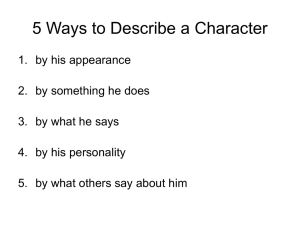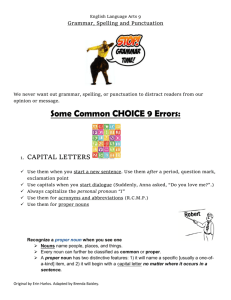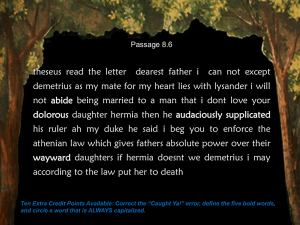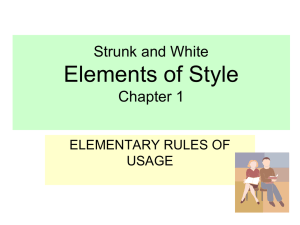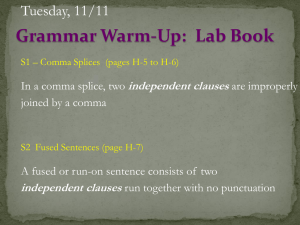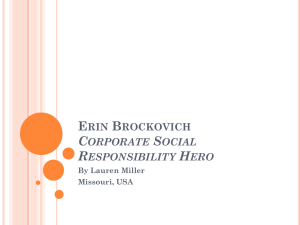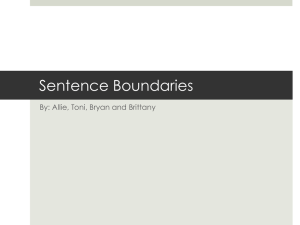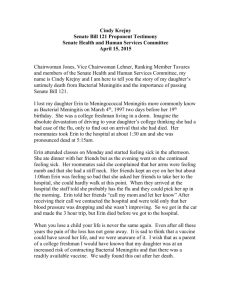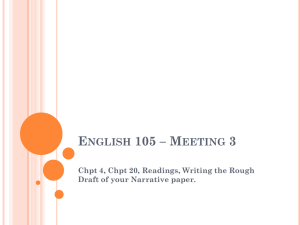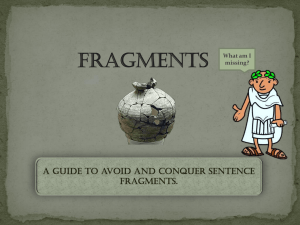No change - Neshaminy School District
advertisement
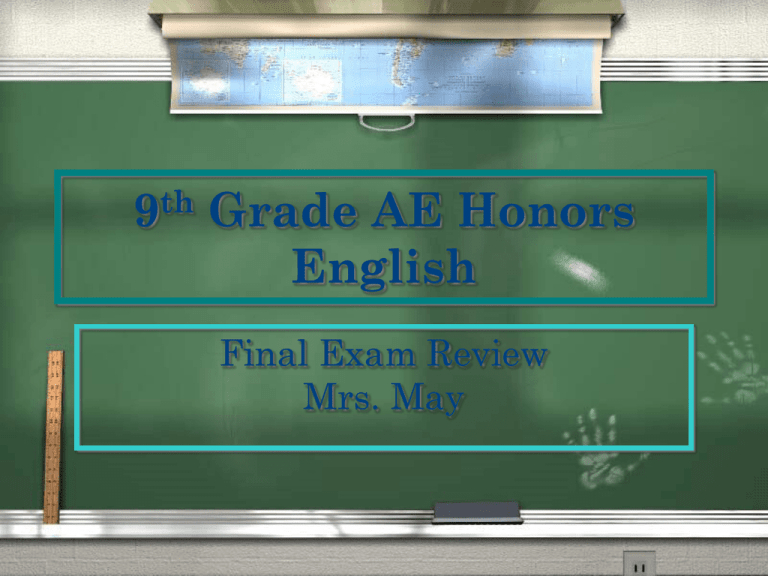
th 9 Grade AE Honors English Final Exam Review Mrs. May Final Exam • 90 multiple choice questions: – 5 Reading Selections: • 2 works of nonfiction – Historical speech – essay • 3 works of fiction – 1 short story – 2 poems – Figurative Language – Grammar, Usage, Mechanics – Vocabulary In Context Figurative Language • • • • • • Hyperbole Imagery Metaphor Onomatopoeia Personification Simile Hyperbole:an exaggerated statement that is not meant to be taken literally; it is used to create a specific reaction. “Atticus, the world is coming to an end…” To Kill A Mockingbird By Harper Lee Imagery: visually descriptive language; usually appeals to one or more of the five senses. “The cry was pinched off short as the blood-warm waters of the Caribbean Sea closed over his head.” From Richard Connell The Most Dangerous Game Metaphor: draws a comparison between two unalike things; WITHOUT using the words “like” or “as”. “My lips, two blushing pilgrims, ready stand To smooth that rough touch with a tender kiss.” Romeo, Act I, sc. v “Thou know'st the mask of night is on my face, Else would a maiden blush bepaint my cheek.” Juliet, Act II, sc. ii. The Tragedy of Romeo & Juliet William Shakespeare Onomatopoeia: “Zing”-- Joey sent a pebble into the blooms. From Marigolds By Eugenia Collier imitates or suggests the source of the sound that it describes. Personification: gives animals, inanimate objects or abstractions human qualities, traits or abilities. “Maycomb was a tired old town, even in 1932 when I first knew it.” “From the day Mr Radley took Arthur home people said the house died." To Kill A Mockingbird Harper Lee Simile: Compares two unalike things using the words “like” or “as”. “She is small and sprightly, like a bantam hen.” A Christmas Memory By Truman Capote Grammar, Usage, Mechanics 20 Questions You will read two short passages with/without embedded “errors”. The “errors” will be underlined throughout the text. Each set of revisions will include the option: NO CHANGE. G.U.M EXAMPLE When Erin Gruwell first stepped through the doors of Room 203 at Woodrow Wilson High School in Long Beach, California, she had no idea how her experiences their would change the course of her life. Fresh out of college, Erin was eager to make a 1 2 difference in her student’s live’s. 3 Choose the letter that indicates the best revision of the underlined word or words. Selection “A” indicates no change needed. 1. 2. 3. A. No change A. No change A. No change B. they’re B. college, Erin B. students’ lives C. they are C. college, Erin C. student’s lives D. there D. college; Erin D. students’ lives’ G.U.M EXAMPLE When Erin Gruwell first stepped through the doors of Room 203 at Woodrow Wilson High School in Long Beach, California, she had no idea how her experiences their would change the course of her life. Fresh out of college, Erin was eager to make a 1 2 difference in her student’s live’s. 3 Choose the letter that indicates the best revision of the underlined word or words. Selection “A” indicates no change needed. 1. 2. 3. A. No change A. No change A. No change B. they’re B. College, Erin B. students’ lives C. they are C. college: Erin C. student’s lives D. there D. college; Erin D. students’ lives’ TYPES OF G.U.M. QUESTIONS • Comma usage – Use a comma to separate items in a series (3 or more things) – Alfonso grabbed his keys, pocketed his wallet, and found his missing shoe just in time to catch the bus. – Use a comma and a conjunction (and, but, for, nor, yet, or, so) to connect two independent clauses. – He thought he had everything he needed for the day, but he left his math homework sitting on the kitchen counter. – Use a comma to set off introductory elements – While sitting on the bus, he asked to borrow Ollie’s book and quickly opened it to page 454. – Use a comma to set off an appositive (noun phrase) – The assignment, which Alfonso had thought would take a minute, was over eighty questions. TYPES OF G.U.M. QUESTIONS • Comma usage – Use a comma to separate items in a series (3 or more things) – Alfonso grabbed his keys, pocketed his wallet, and found his missing shoe just in time to catch the bus. – Use a comma and a conjunction (and, but, for, nor, yet, or, so) to connect two independent clauses. – He thought he had everything he needed for the day, but he left his math homework sitting on the kitchen counter. – Use a comma to set off introductory elements – While sitting on the bus, he asked to borrow Ollie’s book and quickly opened it to page 454. – Use a comma to set off an appositive (noun phrase) – The assignment, which Alfonso had thought would take a minute, was over eighty questions. Commonly Misused Words • • • • • • • • • a lot your/you’re their/there/they’re new/knew no/know it’s/its too/to/two a/an weather/whether There is no such word as “A LOT”; a lot of people forget that. There is a word “allot” which means to assign an amount or share; example: “You should allot twenty minutes for traffic when considering what time to leave.” If you like something a great deal… you like it a lot. Put A LOT of space between the two words “a” and the “l”. your Y-O-U-R is a possessive pronoun. Your final will have 90 questions. you’re Y-O-U-’-R-E is a contraction for two words: “you” and “are. You’re going to do well on the final. Their Is a possessive, plural, pronoun. Their family will be arriving tomorrow. There Is an adverb that indicates the manner in which something is done; it answers the question “where”. Put their suitcases there. They’re Is a contraction for two words:the pronoun they and the verb are. They’re going to have enjoy their family while there. knew new Is a verb Is an adjective Jillian knew that she would need a new car. Jillian knew that she would need a new car. know no Is a verb Can be used as many parts of speech, but is most often used as an adjective. I know that there is I know that there is no reason to doubt no reason to doubt my friend. my friend. its It’s Is a possessive pronoun; Is an contraction for the two words “it” and “is” There is no apostrophe for the possessive for of it. It’s time for the dog to bury its bone. It’s can only mean IT IS It’s time for the dog to bury its bone. Too Is an adverb; it can mean excessive or in addition to. Give these books to the two girls who are going too. Two Is a noun when used as a number. To Is a preposition used for expressing destination or direction. Is an adjective when used to describe a noun. Give these books to the two girls who are going too. Give these books to the two girls who are going too. a and an (both words are articles) “a” goes before all words beginning with consonants, EXCEPT before an unsounded “H” a cat, a dog, a popsicle, a beat, a notebook, a hat, a hotel an historic even, an honest error “an” goes before all words that begin with vowels, EXCEPT when “u” makes the same sound as the “y” in you, or “o” makes the same sound as “w” in won An apricot, an elephant, an Indian, an orbit, an uprising, an uneventful day a unit, a used napkin, a U.S. soldier, a one-act play, a unicorn weather whether Is a noun Is a conjunction; used to introduce alternatives. The wedding was scheduled to start at noon whether or not the weather was cooperating. The wedding was scheduled to start at noon whether or not the weather was cooperating. Always Capitalize: • the pronoun “I” • Proper nouns, specifc persons, places, things, ideas (Democracy) • the first letter of the first word of each sentence • The first letter of adjectives that are made from the names of people and places. Example: I like Brazilian food. • Initials. Example: J.D. Salinger is one of my favorite authors. • The first letter of directions only when they are used to designate actual places, NOT when they point in a direction. Examples: 1. When we visited the Southwest, we actually had to drive north. 2. I haven’t ever been to the West Coast. The west coast of Australia is beautiful. VOCABULARY IN CONTEXT 1. Acquiescence 11. Iota 2. Affable 12. Lacerated 3. Ambidextrous 13. Phantom 4. Amenities 14. Scruples 5. Auspicious 15. Sojourn 6. Benevolence 16. Solicitously 7. Complacently 17. Tangible 8. Deplorable 18. Vehement 9. Imperative 19. Volition 10. Imprudent 20. Zealous VOCABULARY IN CONTEXT acquiescence consent; acceptance affable friendly ambidextrous ability to use both hands interchangeably amenities conveniences, auspicious momentous, impressive VOCABULARY IN CONTEXT benevolence charity complacently smugly, contentedly, confidently, satisfactorily deplorable terrible imperative mandatory imprudent unwise VOCABULARY IN CONTEXT iota small, or tiny amount lacerated wounded, cut, torn phantom specter, apparition, ghost, haunt, spook scruples morals, principles, personal code of conduct sojourn short stay or trip VOCABULARY IN CONTEXT solicitously with concern and caution tangible vehement able to be touched, held or felt full of emotion, adamant volition choice, accord zealous accomplished, skilled, Literature Terms Conflict Internal External Types of Conflict Man vs. Man Man vs. Self Man vs. Society Man vs. Nature Man vs. Fate/God Point of View First Person: the story is being told by one of the characters in it; uses the pronouns I, me, my. When he was nearly thirteen, my brother Jem got his arm badly borken at the elbow. Maycomb was a tired old town, even in 1932 when I first knew it. Point of View Third Person Limited: the story is told from one character’s point of view, BUT, we know the thoughts and feeling only of that character; uses “he said” and “she said”. Point of View Third Person Omniscient: We know the thoughts and feelings of ALL the characters; God-like, or all-knowing presence.
